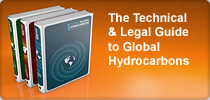THE TECHNICAL AND LEGAL GUIDE TO GLOBAL HYDROCARBONS
BOOK 1 – Preview
Chapter 1 – The Evolution of the World Petroleum Industry
Chapter 1 examines the growth and importance of the world petroleum industry since 1945, looking at the major issues and events which have shaped the industry. In particular, the effect of world politics on volatile oil markets is discussed. The changing roles of international oil companies and the increase in state owned companies is also considered, together with the subsequent effect of this on world oil supplies.
Image - Forties field, UK North Sea (Credit: Mark A. Leman / Stone / Getty Images)
Chapter 2 – Oil Markets, Futures and Issues
Chapter 2 focuses on global oil markets. It analyses key market players, including suppliers, consumers and OPEC. The oil pricing system and the behaviour of oil prices is examined. Other key market issues are also discussed, including the peak oil debate, climate change and oil security.
 Chapter 3 – International Gas Markets
Chapter 3 – International Gas Markets
Chapter 3 provides an overview of international gas markets, including the market for LNG. The major regional gas markets are examined, with the focus on the impact they have on international gas trade. Key issues within these markets are also discussed, such as pricing mechanisms, supply and demand and exports.
Image - Onshore LNG plant, North West Shelf Venture (Credit: Peter Hendrie / Getty Images)
Chapter 4 – Origins of Conventional and Unconventional Hydrocarbons
Chapter 4 discusses the geological origins of conventional and unconventional oil and gas, setting out what makes a hydrocarbon conventional or unconventional. The principal forms of unconventional hydrocarbons, namely heavy oil; oil (or tar) sands; oil shale; tight gas sands; shale gas; coalbed methane; CMM and AMM; natural gas hydrates; and LNG, are all considered.
Chapter 5 – Oil Lifting, Trading and Transportation
Technical
The technical section of Chapter 5 examines the key stages in crude oil trading - valuation, selection, trading, marketing, transportation (both marine and pipeline) and storage. Important factors within each of these six stages are discussed, such as crude oil assays; pricing; the mechanics of trading; quantity and quality measurement; and tariffs and scheduling.
Legal
Chapter 5's legal section looks at how crude oil is disposed of once lifted, analysing lifting agreements, oil trading, sale and purchase agreements and transportation agreements for the sale of oil. It gives the reader a commercial overview of how these key agreements work in practice.
Image - The Gemini Star oil tanker (Credit: Bloomberg via Getty Images)
 Chapter 6 – Crude Oil Refining and How it is Changing
Chapter 6 – Crude Oil Refining and How it is Changing
Chapter 6 is split into three parts. Part 1 looks at crude oil refining technologies. Part 2 goes on to examine various legal and commercial considerations taken into account when negotiating an Oil Processing Agreement, including services; commencement and term; quantity and quality; tariff; risk, title and insurance; tax and duties; and liabilities and indemnities. Part 3 then considers the changing face of refining worldwide, looking at how changes over the next 30 years will impact on the dynamics of global oil refining.
Image - Distillation towers (Credit: Steve Allen / Getty Images)
 Chapter 7 – Gas Sales, Transportation, Marketing and Distribution
Chapter 7 – Gas Sales, Transportation, Marketing and Distribution
Technical
The technical section of Chapter 7 provides a detailed overview of commercial practices across the world's natural gas industries and markets. It looks at production in different countries and regions; global gas demand; European gas markets and trading; and gas pricing mechanisms.
Legal
Chapter 7's legal section examines the legal aspects of exploration, production, sale, storage and transportation of natural gas. In particular, it analyses the key provisions of gas sales and transportation agreements. It also considers the regulation of natural gas production across the world, providing overviews of the regulatory regimes of various countries and regions.
Image - The New York Mercantile Exchange (Credit: Spencer Platt / Getty Images)
 Chapter 8 – Underground Gas Storage
Chapter 8 – Underground Gas Storage
Technical
Chapter 8 opens with an examination of the need for natural gas storage in general and the different types of storage that are available, before going on to discuss underground gas storage (UGS) in detail. Different forms of UGS are considered, with a focus on depleted reservoir, aquifer and salt cavern storage. Various important commercial and economic factors are also set out, such as security and decommissioning.
Legal
The legal section of Chapter 8 considers some of the key legal and commercial issues relating to UGS, including which entity grants the necessary rights; the regulatory regime for such grants; the regime granting access to storage facilities; and the contractual arrangements required to implement a storage project. The examples of Michigan in the USA, Alberta in Canada, the Netherlands and the UK are used to provide examples of the different approaches taken to these key issues across the world.
Image - Underground natural gas storage facility, Germany (Credit: Christian Behrens / Bloomberg via Getty Images)
Chapter 9 – LNG Production and Trading
Technical
The technical section of Chapter 9 provides an overview of the key stages of LNG production, including production from natural gas; storage; transportation and shipping; regasification; and integration into gas distribution networks. It also looks at various important commercial considerations, including LNG quality; safe handling of transportation, loading and unloading; and global production, shipping and marketing.
Legal
Chapter 9's legal section provides a commercial overview of the LNG supply chain, project structures and finance. It also examines several key agreements, including feedstock gas sale and purchase agreements; LNG sale and purchase agreements; shipbuilding contracts; time charters; and terminal use agreements for regasification.
Buy a hard copy of Book 1: The Technical & Legal Guide to Global Hydrocarbons here.
Buy an electronic copy of Book 1: The Technical & Legal Guide to Global Hydrocarbons here.





